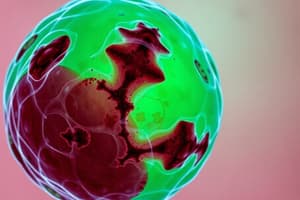Podcast
Questions and Answers
What is the primary cause of necrosis?
What is the primary cause of necrosis?
- Controlled cellular signaling
- Apoptotic pathways activation
- Malfunction of membrane transport mechanisms
- Enzymatic degradation of cellular components (correct)
Which of the following is NOT a characteristic of necrotic cells?
Which of the following is NOT a characteristic of necrotic cells?
- Intact membrane integrity (correct)
- More homogeneous appearance
- Increased eosinophilia
- Vacuolated appearance
In which morphological feature does necrosis and apoptosis primarily differ?
In which morphological feature does necrosis and apoptosis primarily differ?
- Size of the dying cells
- Cytoplasmic density
- Vacuolization of the cytoplasm
- Nuclear changes (correct)
What does increased eosinophilia in necrotic cells indicate?
What does increased eosinophilia in necrotic cells indicate?
What does pyknosis in necrotic cells signify?
What does pyknosis in necrotic cells signify?
Which nuclear change occurs due to the activity of deoxyribonucleases during necrosis?
Which nuclear change occurs due to the activity of deoxyribonucleases during necrosis?
What happens to the nucleus of a dead cell within 1 to 2 days?
What happens to the nucleus of a dead cell within 1 to 2 days?
Which of the following best describes the morphological changes accompanying necrosis?
Which of the following best describes the morphological changes accompanying necrosis?
What is the primary event that characterizes apoptosis?
What is the primary event that characterizes apoptosis?
Which pathway of apoptosis is triggered by signals from plasma membrane receptors?
Which pathway of apoptosis is triggered by signals from plasma membrane receptors?
What role do cytotoxic T lymphocytes play in apoptosis?
What role do cytotoxic T lymphocytes play in apoptosis?
In which scenario does apoptosis serve to prevent tissue destruction?
In which scenario does apoptosis serve to prevent tissue destruction?
What is NOT a cause for apoptosis in pathologic conditions?
What is NOT a cause for apoptosis in pathologic conditions?
What happens to the mitochondria during the mitochondrial pathway of apoptosis?
What happens to the mitochondria during the mitochondrial pathway of apoptosis?
Which of the following is a consequence of insufficient removal of cellular substances?
Which of the following is a consequence of insufficient removal of cellular substances?
What is the result of activated caspases in the apoptosis process?
What is the result of activated caspases in the apoptosis process?
What condition is characterized by the deposition of calcium salts in normal tissues?
What condition is characterized by the deposition of calcium salts in normal tissues?
Which of the following is NOT a cause of hypercalcemia?
Which of the following is NOT a cause of hypercalcemia?
Where does metastatic calcification typically occur in the body?
Where does metastatic calcification typically occur in the body?
Which of the following statements about dystrophic calcification is true?
Which of the following statements about dystrophic calcification is true?
What is the appearance of calcium deposits in dystrophic calcification at a microscopic level?
What is the appearance of calcium deposits in dystrophic calcification at a microscopic level?
What is the primary mechanism through which fat necrosis occurs?
What is the primary mechanism through which fat necrosis occurs?
Which characteristic is NOT associated with apoptosis?
Which characteristic is NOT associated with apoptosis?
What is produced when fatty acids combine with calcium during fat necrosis?
What is produced when fatty acids combine with calcium during fat necrosis?
In which physiological situation is apoptosis particularly important?
In which physiological situation is apoptosis particularly important?
What microscopic feature is commonly seen in apoptotic cells?
What microscopic feature is commonly seen in apoptotic cells?
What distinguishes necrosis from apoptosis?
What distinguishes necrosis from apoptosis?
Which type of necrosis is characterized by protein deposition and inflammation?
Which type of necrosis is characterized by protein deposition and inflammation?
What happens to the cellular contents during apoptosis?
What happens to the cellular contents during apoptosis?
What causes macrophages to develop a foamy appearance within atherosclerotic plaques?
What causes macrophages to develop a foamy appearance within atherosclerotic plaques?
What type of cells accumulate intracellular cholesterol in xanthomas?
What type of cells accumulate intracellular cholesterol in xanthomas?
Which condition is typically associated with excessive glycogen accumulation?
Which condition is typically associated with excessive glycogen accumulation?
What is the primary cause of anthracosis?
What is the primary cause of anthracosis?
What pathological process leads to the formation of xanthomas?
What pathological process leads to the formation of xanthomas?
The degradation of which substances can lead to cell death in glycogen storage diseases?
The degradation of which substances can lead to cell death in glycogen storage diseases?
What is one result of excessive intracellular cholesterol accumulation in macrophages?
What is one result of excessive intracellular cholesterol accumulation in macrophages?
What type of substances are pigments referred to in pathological context?
What type of substances are pigments referred to in pathological context?
Flashcards are hidden until you start studying
Study Notes
Cell Injury: Necrosis and Apoptosis
- Necrosis: Morphological changes due to cell death from enzyme degradation.
- Necrotic cells lose membrane integrity, leaking cytoplasmic contents.
- Enzymes from lysosomes of dying cells or recruited leukocytes cause necrosis.
Morphological Features of Necrosis
- Cytoplasmic Changes: Increased eosinophilia (deep pink staining) due to denatured proteins and loss of RNA basophilia.
- Nuclear Changes:
- Karyolysis: Fading basophilia of chromatin due to DNase activity.
- Pyknosis: Nuclear shrinkage and DNA condensation into solid mass.
- Karyorrhexis: Fragmentation of pyknotic nucleus; disappearance of nucleus within days.
Patterns of Necrosis
- Caseous Necrosis: Characterized by cheese-like appearance; typically associated with tuberculosis.
- Fat Necrosis: Seen in acute pancreatitis; pancreatic lipases digest fat tissue, leading to saponification and chalky white deposits.
- Fibrinoid Necrosis: Involves protein deposition and inflammation within tissues.
Apoptosis
- Defined as a regulated apoptotic program where cells activate enzymes to degrade internal components.
- Unlike necrosis, apoptosis does not provoke an inflammatory response; cell membranes remain intact during fragmentation.
Microscopic Features of Apoptosis
- Apoptotic cells often appear as round masses with eosinophilic cytoplasm.
- Nuclear chromatin condenses, leading to fragmentation (karyorrhexis).
- Apoptotic bodies form, which are phagocytosed quickly.
Causes of Apoptosis
-
Physiological Situations:
- Embryogenesis and organogenesis.
- Hormonal tissue regression (e.g., menstrual cycle, breast weaning, prostatic atrophy).
- Normal turnover in proliferating tissues (e.g., intestinal epithelium, neutrophils, lymphocytes).
-
Pathological Conditions:
- Targets genetically altered or irreparably damaged cells.
- Induced by DNA damage and accumulation of misfolded proteins.
Mechanism of Apoptosis
- Key event: Activation of caspases leading to DNA degradation.
- Two pathways:
- Mitochondrial Pathway: Triggered by loss of survival signals; involves Bcl-2 family proteins.
- Death Receptor Pathway: Signals from membrane receptors creating a death-inducing signaling complex activating caspases.
Cellular Accumulation
- Abnormal accumulation of substances can be harmless or harmful, occurring in cytoplasm, nucleus, or organelles.
- Pathways of accumulation include inadequate removal and defective transport.
Specific Accumulations
-
Cholesterol Accumulation:
- Macrophages ingest lipid debris, becoming foam cells in atherosclerosis.
- Xanthomas form in skin/connective tissues due to macrophage lipid accumulation.
-
Glycogen Accumulation:
- Seen in poorly controlled diabetes mellitus and glycogen storage diseases; results in significant intracellular deposits.
-
Pigments: Can be exogenous (e.g., carbon from air pollution) or endogenous (synthesized within body).
- Heavy accumulation may cause diseases like coal workers' pneumoconiosis.
Calcification
- Dystrophic Calcification: Local calcium salt deposition due to tissue necrosis or damage (e.g., atherosclerosis, aging heart valves).
- Metastatic Calcification: Widespread deposits in hypercalcemia cases, primarily affecting vessels, kidneys, lungs, and gastrointestinal tissues.
Causes of Hypercalcemia
- Increased secretion of parathyroid hormone.
- Bone destruction (e.g., Paget disease).
- Vitamin D-related disorders.
- Renal failure leading to phosphate retention and secondary hyperparathyroidism.
Studying That Suits You
Use AI to generate personalized quizzes and flashcards to suit your learning preferences.




